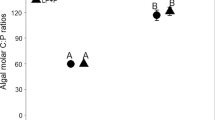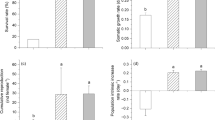Abstract
Primary producers may be limited by different nutrients as well as by light availability, which in turn affects their quality as food for higher trophic levels. Typically, algae with high C:N and/or C:P ratios are low-quality food for consumers. Heterotrophic protists are important grazers on these autotrophes, but despite their importance as grazers, knowledge of food quality effects on heterotrophic protists is sparse. In the present study, we examined how differently grown Rhodomonas salina (nutrient replete, N-limited and P-limited) affected the phagotrophic flagellate Oxyrrhis marina. The functional response of O. marina (based on ingested biovolume) did not show significant differences between food sources, thus food uptake was independent of food quality. O. marina was weakly homoeostatic which means that its C:N:P ratio still reflected the elemental composition of its food to some extent. Food quality had a significantly negative effect on the numerical response of O. marina. Whereas N-limited R. salina and nutrient replete R. salina resulted in similar growth rates, P-limited algae had a significantly negative effect on the specific growth rate of O. marina. Hence, the lack of elemental phosphorus of O. marina feeding on P-limited algae caused a reduction in growth. Thus, despite their weaker homoeostasis, heterotrophic protists are also affected by high C:P food in a similar way to crustacean zooplankton.






Similar content being viewed by others
References
Aberle N, Malzahn AM (2007) Interspecific and nutrient-dependent variations in stable isotope fractionation: experimental studies simulating pelagic multitrophic systems. Oecologia 154:291–303
Anderson TR, Hessen DO, Elser JJ, Urabe J (2005) Metabolic stoichiometry and the fate of excess carbon and nutrients in consumers. Am Nat 165:1–15
Augustin CB, Boersma M (2006) Effects of nitrogen stressed algae on different Acartia species. J Plankton Res 28:429–436
Barlow RG, Burkill PH, Mantoura RFC (1988) Grazing and degradation of algal pigments by marine protozoan Oxyrrhis marina. J Exp Mar Biol Ecol 119:119–129
Boersma M, Kreutzer C (2002) Life at the edge: is food quality really of minor importance at low quantities? Ecology 83:2552–2561
Burns CW (1995) Effects of crowding and different food levels on growth and reproductive investment of Daphnia. Oecologia 101:234–244
Burns CW (2000) Crowding-induced changes in growth, reproduction and morphology of Daphnia. Freshw Biol 43:19–29
Clark LL, Ingall ED, Benner R (1998) Marine phosphorus is selectively remineralized. Nature 393:426–436
Darchambeau F, Faerovig PJ, Hessen DO (2003) How Daphnia copes with excess carbon in its food. Oecologia 136:336–346
Davidson K, Roberts EC, Wilson AM, Mitchell E (2005) The role of prey nutritional status in governing protozoan nitrogen regeneration efficiency. Protist 156:45–62
DeMott WR, Gulati RD, Van Donk E (2001) Effects of dietary phosphorus deficiency on the abundance, phosphorus balance, and growth of Daphnia cucullata in three hypereutrophic Dutch lakes. Limnol Oceanogr 46:1871–1880
Ederington MC, Mcmanus GB, Harvey HR (1995) Trophic transfer of fatty acids, sterols, and a triterpenoid alcohol between bacteria, a ciliate, and the copepod Acartia tonsa. Limnol Oceanogr 40:860–867
Elser JJ (2002) Biological stoichiometry from genes to ecosystems: ideas, plans, and realities. Integr Comp Biol 42:1226–1326
Elser JJ, Hassett RP (1994) A stoichiometric analysis of the zooplankton-phytoplankton interaction in marine and freshwater ecosystems. Nature 370:211–213
Flynn KJ, Davidson K (1993) Predator-prey interactions between Isochrysis galbana and Oxyrrhis marina II. Release of nonprotein amines and faeces during predation of Isochrysis. J Plankton Res 15:893–905
Flynn KJ, Davidson K, Cunningham A (1996) Prey selection and rejection by a microflagellate: implications for the study and operation of microbial food webs. J Exp Mar Biol Ecol 196:357–372
Frost BW (1972) Effects of size and concentration of food particles on feeding behavior of marine planktonic copepod Calanus pacificus. Limnol Oceanogr 17:805–815
Gismervik I (2006) Top-down impact by copepods on ciliate numbers and persistence depends on copepod and ciliate species composition. J Plankton Res 28:499–507
Goldman JC, Caron DA, Dennett MR (1987) Nutrient cycling in a microflagellate food chain: IV. Phytoplankton-microflagellate interactions. Mar Ecol Prog Ser 38:75–87
Goldman JC, Dennett MR, Gordin H (1989) Dynamics of herbivorous grazing by the heterotrophic dinoflagellate Oxyrrhis marina. J Plankton Res 11:391–407
Gonzalez JM, Sherr EB, Sherr BF (1993) Differential feeding by marine flagellates on growing versus starving, and on motile versus nonmotile, bacterial prey. Mar Ecol Prog Ser 102:257–267
Grasshoff K, Kremling K, Ehrhardt M (1999) Methods of seawater analysis. Wiley-VCH, Weinheim
Grover JP, Chrzanowski TH (2006) Stoichiometry and growth kinetics in the “smallest zooplankton”—phagotrophic flagellates. Arch Hydrobiol 167:467–487
Guillard RRL, Ryther JH (1962) Studies of marine planktonic diatoms. I. Cyclotella nana Hustedt and Detonula confervacea Cleve. Can J Microbiol 8:229–239
Hammer A, Gruttner C, Schumann R (2001) New biocompatible tracer particles: use for estimation of microzooplankton grazing, digestion, and growth rates. Aquat Microb Ecol 24:153–161
Hansen FC, Witte HJ, Passarge J (1996) Grazing in the heterotrophic dinoflagellate Oxyrrhis marina: size selectivity and preference for calcified Emiliania huxleyi cells. Aquat Microb Ecol 10:307–313
Hazzard SE, Kleppel GS (2003) Egg production of the copepod Acartia tonsa in Florida Bay: role of fatty acids in the nutritional composition of the food environment. Mar Ecol Prog Ser 252:199–206
Helgen JC (1987) Feeding rate inhibition in crowded Daphnia pulex. Hydrobiologia 154:113–119
Hessen DO, Faerovig PJ, Andersen T (2002) Light, nutrients, and P: C ratios in algae: grazer performance related to food quality and quantity. Ecology 83:1886–1898
Hessen DO, Agren GI, Anderson TR, Elser JJ, De Ruiter PC (2004) Carbon sequestration in ecosystems: the role of stoichiometry. Ecology 85:1179–1192
Howarth RW (1988) Nutrient limitation of net primary production in marine ecosystems. Annu Rev Ecol Syst 19:89–110
Jensen TC, Hessen DO (2007) Does excess dietary carbon affect respiration of Daphnia? Oecologia 152:191–200
Jeong HJ, Kim JS, Yeong DY, Kim ST, Kim TH, Park MG, Lee CH, Seong KA, Kang NS, Shim JH (2003) Feeding by the heterotrophic dinoflagellate Oxyrrhis marina on the red-tide raphidophyte Heterosigma akashiwo: a potential biological method to control red tides using mass-cultured grazers. J Eukaryot Microbiol 50:274–282
Jeong HJ, Song JE, Kang NS, Kim S, Yoo YD, Park JY (2007) Feeding by heterotrophic dinoflagellates on the common marine heterotrophic nanoflagellate Cafeteria sp. Mar Ecol Prog Ser 333:151–160
Johnson MP (2000) Physical control of plankton population abundance and dynamics in intertidal rock pools. Hydrobiologia 440:145–152
Jonasdottir SH (1994) Effects of food quality on the reproductive success of Acartia tonsa and Acartia hudsonica: laboratory observations. Mar Biol 121:67–81
Kimmance SA, Atkinson D, Montagnes DJS (2006) Do temperature-food interactions matter? responses of production and its components in the model heterotrophic flagellate Oxyrrhis marina. Aquat Microb Ecol 42:63–73
Klein B, Gieskes WWC, Kraay GG (1986) Digestion of chlorophylls and carotenoids by the marine protozoan Oxyrrhis marina studied by H.P.L.C analysis of algal pigments. J Plankton Res 8:827–836
Kolowith LC, Ingall ED, Benner R (2001) Composition and cycling of marine organic phosphorus. Limnol Oceanogr 46:309–320
Koski M (1999) Carbon: nitrogen ratios of Baltic Sea copepods—indication of mineral limitation? J Plankton Res 21:1565–1573
Malzahn AM, Aberle N, Clemmesen C, Boersma M (2007) Nutrient limitation of primary producers affects planktivorous fish condition. Limnol Oceanogr 52:2062–2071
Martin-Creuzburg D, von Elert E (2004) Impact of 10 dietary sterols on growth and reproduction of Daphnia galeata. J Chem Ecol 30:483–500
Nakano S (1994) Carbon: nitrogen: phosphorus ratios and nutrient regeneration of a heterotrophic flagellate fed on bacteria with different elemental ratios. Arch Hydrobiol 129:257–271
Opik H, Flynn KJ (1989) The digestive process of the dinoflagellate Oxyrrhis marina Dujardin feeding on the chlorophyte Dunaliella primolecta Butcher: a combined study of ultrastructure and free amino acids. New Phyt 113:143–151
Pedersen MF, Hansen PJ (2003) Effects of high pH on the growth and survival of six marine heterotrophic protists. Mar Ecol Prog Ser 260:33–41
Plath K, Boersma M (2001) Mineral limitation of zooplankton: stoichiometric constraints and optimal foraging. Ecology 82:1260–1269
Selph KE, Landry MR, Laws EA (2003) Heterotrophic nanoflagellate enhancement of bacterial growth through nutrient remineralization in chemostat culture. Aquat Microb Ecol 32:23–37
Skovgaard A (1996) Mixotrophy in Fragilidium subglobosum (Dinophyceae): growth and grazing responses as functions of light intensity. Mar Ecol Prog Ser 143:247–253
Sterner RW, Elser JJ (2002) Ecological stoichiometry: the biology of elements from molecules to the biosphere. Princeton University Press, Princeton
Sterner RW, Robinson JL (1994) Thresholds for growth in Daphnia magna with high and low phosphorus diets. Limnol Oceanogr 39:1228–1232
Strom SL, Benner R, Ziegler S, Dagg MJ (1997) Planktonic grazers are a potentially important source of marine dissolved organic carbon. Limnol Oceanogr 42:1364–1374
Tang KW, Taal M (2005) Trophic modification of food quality by heterotrophic protists: species-specific effects on copepod egg production and egg hatching. J Exp Mar Biol Ecol 318:85–98
Tarran GA (1991) Aspects of the grazing behaviour of the marine dinoflagellate Oxyrrhis marina, Dujardin
Tillmann U, Reckermann M (2002) Dinoflagellate grazing on the raphidophyte Fibrocapsa japonica. Aquat Microb Ecol 26:247–257
Uitto A, Hallfors S (1997) Grazing by mesozooplankton and metazoan microplankton on nanophytoplankton in a mesocosm experiment in the northern Baltic. J Plankton Res 19:655–673
Verity PG (1985) Grazing, respiration, excretion, and growth rates of tintinnids. Limnol Oceanogr 30:1268–1282
Verity PG (1991) Measurement and simulation of prey uptake by marine planktonic ciliates fed plastidic and aplastidic nanoplankton. Limnol Oceanogr 36:729–750
von Elert E (2002) Determination of limiting polyunsaturated fatty acids in Daphnia galeata using a new method to enrich food algae with single fatty acids. Limnol Oceanogr 47:1764–1773
Vrede T, Persson J, Aronsen G (2002) The influence of food quality (P: C ratio) on RNA: DNA ratio and somatic growth rate of Daphnia. Limnol Oceanogr 47:487–494
Acknowledgments
This study is a part of the PhD studies conducted by F.M.H. at the Biologische Anstalt Helgoland, Alfred-Wegener-Institut Bremerhaven, Germany, financed by GKSS Geesthacht, Germany, and complies with current German law on animal studies. We thank Daniel Schütz, Jacob Hauschildt and Anneke Purz for laboratory assistance and Martin Löder, Christina Gebühr, Katherina Schoo, Petra Brandt, Arne Malzahn and Nils Gülzow for useful discussions. Special thanks to Prof. Dr. Sebastian Diehl and two anonymous reviewers whose suggestions improved the manuscript.
Author information
Authors and Affiliations
Corresponding author
Additional information
Communicated by U.-G. Berninger.
Rights and permissions
About this article
Cite this article
Hantzsche, F.M., Boersma, M. Dietary-induced responses in the phagotrophic flagellate Oxyrrhis marina . Mar Biol 157, 1641–1651 (2010). https://doi.org/10.1007/s00227-010-1437-1
Received:
Accepted:
Published:
Issue Date:
DOI: https://doi.org/10.1007/s00227-010-1437-1




